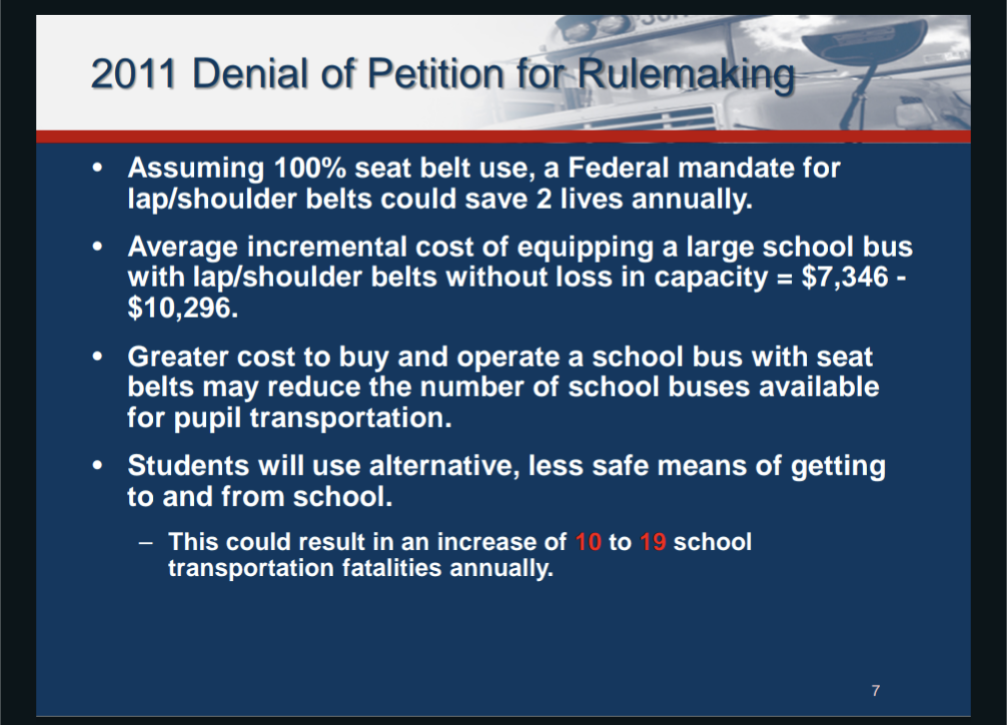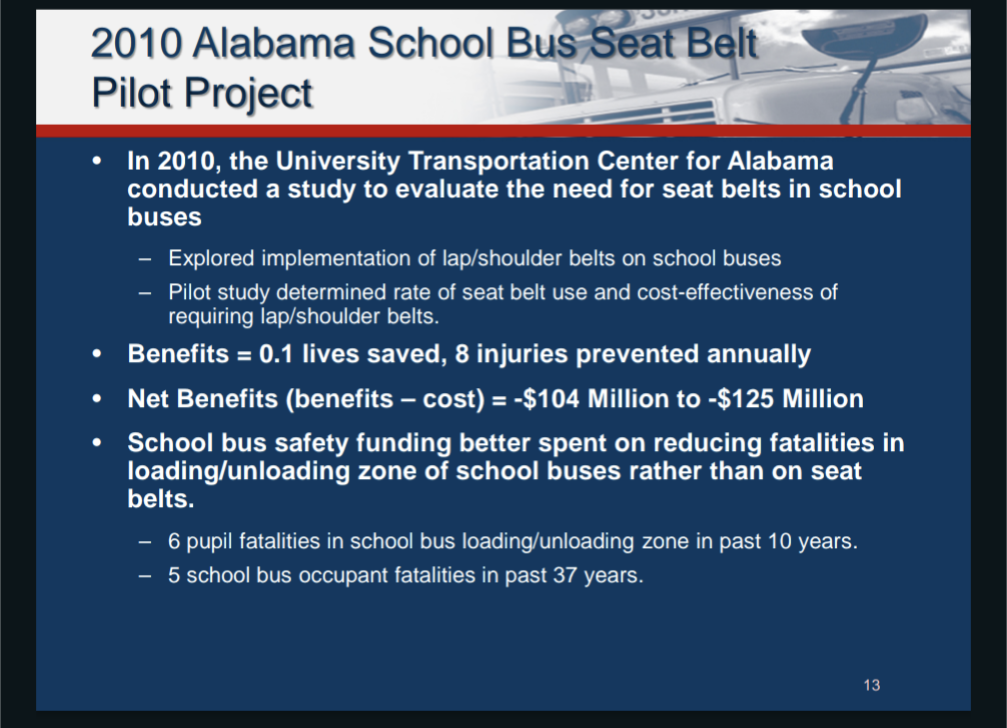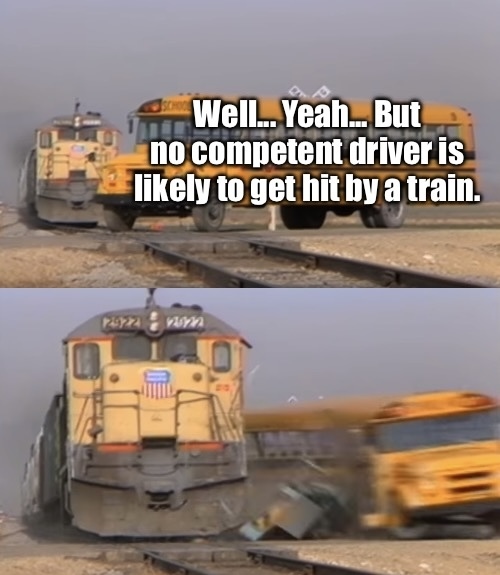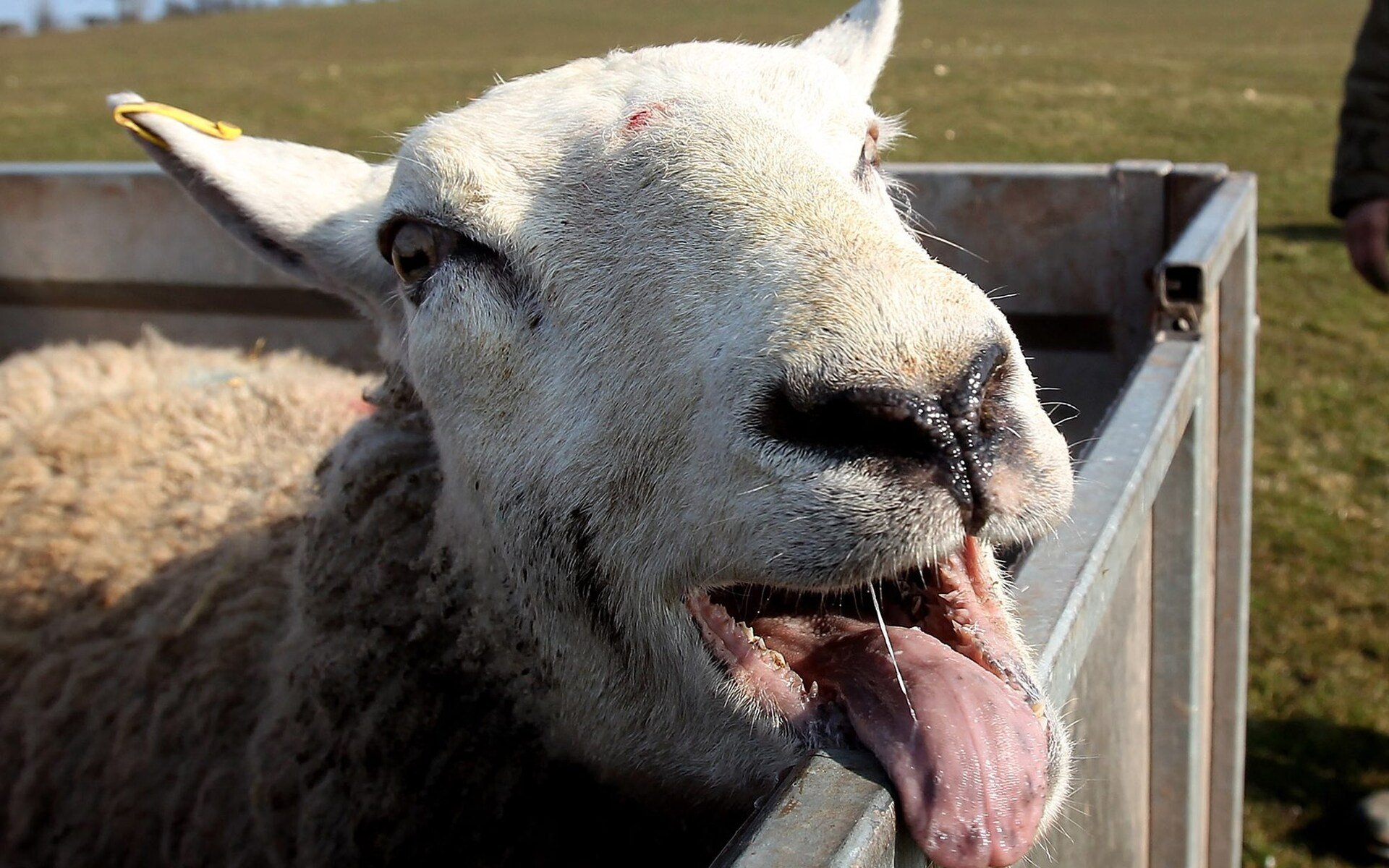The reason the bus driver has a seat belt and the kids don’t is because the kids have a padded seat back in front of them to stop them from launching forward in a crash. The bus driver has nothing but glass and the open road in front of them to stop them from launching forward in a crash. And seat belts help protect the bus driver from the airbags as they deploy from the steering wheel which have been known to deploy so forcefully that if you’re not wearing a seat belt they can kill you, and even in some extreme circumstances completely decapitate you.
Also as someone else pointed out the kids could get trapped in their seats in the event of a fire. The bus driver has a little seat belt cutting tool available to them, but in a fire they might not have time to cut 72 seat belts to free all of the kids on a big bus.
You might ask, well what if the bus rolls? It’s pretty unlikely that the bus would roll because bus drivers are trained pretty extensively and have to go through periodic medical exams and driving exams to make sure they’re capable of doing the job safely. Even if the bus were in a situation where it might roll, it’s very bottom heavy so it would take quite a lot to get it to tip over.
Other countries have seatbelts on school buses, so it’s not exactly some cut and dry question.
It’s not even the case in all US states.The NTSB recommends that we start enforcing seat belts on school buses.
https://www.ntsb.gov/Advocacy/safety-topics/Pages/schoolbuses.aspxThey agree with what you said, but disagree that the risk of being trapped outweighs the risk of being fired face first into a seat back.
As a school bus driver, I can say there is ZERO chance of being able to make the kids actually wear the seat belts.
That’s what I always assumed was the reason for designing them to be safe without belts.
There were belts on couple of the front seats when I was a kid (mid 80s).
Ironically that state had only just started making seatbelts mandatory for minors (I think under 16 or maybe just under 12). There were kids riding around in the back of pickup trucks on main roads when we first moved there.
The used school bus I bought spent its working life in Buffalo where state law requires all buses to have seat belts. Most of them had been stuffed down behind the backrests and none of them showed even the slightest bit of wear despite 15 years in service.
Interesting. I live in southern Ontario and we definitely don’t have seat belts on buses here.
We mostly don’t here in the US, either. It’s not federally required for them to have seat belts, but that may change in the future based off things like the NTSB’s recommendation.
An interesting stat about school buses is that over the last 20 years or so, there has been a roughly equal number of bus driver deaths and passenger deaths. Since a school bus typically carries a much larger number of passengers (as many as 70 or more) than drivers (1), this means that the risk of death for the driver is far higher than that for the passengers (although exactly how much riskier it is is difficult to determine from the published data).
Another interesting safety feature of school buses is that the bus bodies are clipped to the chassis rails rather than being bolted or welded to them and thus are held in place solely by friction. This is so that the bus body can slide forward a couple of feet along the rails in the event of a head-on collision, which greatly reduces the deceleration forces experienced by the passengers (this crash test video shows the phenomenon clearly). This does not help the driver much either as they’re sliding forward into the engine compartment or into the oncoming vehicle in the case of flat-front buses.
It’s pretty unlikely that the bus would roll
Yeah, buses really aren’t going to roll unless they get hit hard on the side by an equally-large vehicle traveling at a high speed - or unless they run afoul of some mythbusters.
The mythbusters clip about the bus is one of my favorites, because it showed just how hard it is to tip over a bus.
Wow I didn’t know about the sliding rails thing. Interesting hidden design.
The fire stuff makes some degree of sense but the “padded seat” thing doesn’t. 1) they aren’t very padded in the back, and 2) by that logic people wouldn’t need to wear seatbelts if they sat in a back seat in any car.
The other advantage of buses is that they have a lot of inertia due to their mass. The most likely thing for them to hit is a car and most likely because that car made a mistake. The bus can easily push a car out of the way without losing too much velocity. The same is not true of your average civilian vehicle.
- by that logic people wouldn’t need to wear seatbelts if they sat in a back seat in any car.
That logic is the exact reason in some places it is(was? My info is a few years old.) legal for adults in the back seat to not wear a seat belt. Not saying I agree with the logic, but that actually is the case in some places.
they aren’t very padded in the back
They’re not exactly well-padded, but other than the outer frame of the backs (which is 1" square steel tubing), the backs are made from stamped 30-gauge sheet steel which deforms quite readily on impact. Kids can get bruised in collisions by impacting the seat backs but they’re usually not badly hurt.
F = ma
A car crash will affect an obsese 250lb bus driver much more than some 40lb little twerp.
Let’s say the bus was traveling at a rate of 60mph🇺🇸 and hit a brick wall, and all passengers uniformly come to a complete stop at precisely 1 second. The 5 year old weighing 40lbs🇺🇸 would experience an impact of around 109 pounds of force (109.40 lbf🇺🇸) whereas the bus driver weighing 250lbs🇺🇸 would experience 683.67 lbf🇺🇸.
I absolutely did NOT run the calculations in 🤮 🇪🇺 🤮 before converting to 😎🇺🇸😎.
High schoolers ride busses too. They’re a little bigger than 40lb twerps at that point.
But they’re objectively the worst kind of child, so meh.
In fact, I think newborns shouldn’t need any restraints at all.
Toss em in the back of the truck on the drive back home from the hospital. They’ll be fine!
I mean, on the other hand, a 5 year old is generally more fragile than an adult man.
Nah. They’re made ot of rubber. They’ll be fine. Anyway, even if they aren’t, it’s not like society invested too much in them yet.
Have you never met a kid? Were you never a kid? The kids that scream and cry over small bumps do it because that’s how they were taught to get attention and the adults feed that.
Kids are (biologically) way more resilient than adults. Their bones are more rubbery and slowly harden over time.
I’ve always thought that humans should just evolve to be smaller now that we’re so smart. We’d need less food, people would be safer in impacts, we could build smaller and more efficient homes, etc. Think of the efficiency of a space program where each astronaut was 1/3 the weight and half the size!
It’s not like we have any natural predators any more, so size isn’t a big deal.
Small bumps are not the same as a vehicle crash. There’s a reason young children can’t sit in the front seat, because air bags deploying can kill them. Kids are small and flexible enough to have an advantage with lower impact stuff, but for high impact stuff they’re smaller and squishier and that extra flexibility doesn’t help as much, and once they hit puberty they mostly lose that because of the reduced cartilage in their skeletons. Younger children are especially vulnerable to head and neck injuries because of their less developed muscles.
Please stop.
You’re arguing about something I didn’t say. I was responding directly to the point about kids being fragile. As you say kids have a major advantage in smaller crashes for similar reasons as to how/why the highly intoxicated can sometimes walk away seemingly without a scratch. If a crash is bad enough to kill a kid, good chance the driver isn’t walking away from it either.
As for kids sitting in the front seat, yes, airbags kill but pre airbags the kid would also be more likely to go through the windshield and that’s also why smaller kids are buckled in facing the back of the back seat, so they have extra protection from the seat they are in. There is also the whole seat belt nit fitting right in the front or back seat and that’s why we have them in something up to a certain weight class. It’s not about age, it’s about height and weight.
Seriously, stop. I didn’t say anything about kids not needing seat belts or other protective measures. I was simply countering something that was definitely not accurate.
Dude, fully grown men are objectively fragile.
Children are objectively small and squishy. Car accidents are one of the leading causes of death for children for a reason.
“padded seat back in front”
I haven’t had to take a school bus in 20 years but from what I remember there isn’t much padding over the frame that goes around the back so I wouldn’t want to get that in my face in a crash!
I was a chaperone on a school trip last year, and the bus had about 3" of foam padding over the frame and just vinyl on the seat back. Plus the sides of the bus were just bare aluminum with screws and sharp corners.
I just want to point out that decapitation, in a medical sense, doesn’t necessarily mean the head is removed from the body. You can be internally decapitated.
Huh, TIL
Like…brain stem shearing? Yuck.
Not necessarily. There are stories of horsemen getting bucked while staying in the saddle and having to hold their head up by the hair while riding to medical attention. They didn’t become quadriplegic but the internal decapitation lost them control of their neck.
Not too sure why it isn’t considered a broken neck though
If you dislocate your elbow, you didn’t break a bone, the joint just came unhinged.
Your spine is a set of joints.
An internal decapitation is basically a “dislocated skull”.It’s only because we have a special word for “head came off” that it’s a bit mixed up.
Colloquially, you probably could call it a broken neck, since I don’t know if anyone particularly cares if the spinal nerve damage was because bone fractured or just came loose, outside of a medical professional.
There are stories of horsemen getting bucked while staying in the saddle and having to hold their head up by the hair while riding to medical attention
Fuck I was not prepared for that horrifying of a read at 3pm on Thursday
School bus drivers have more oversight than police huh?
Hair stylists have more oversight than police.
School bus drivers are going under significantly less training and requirements in my affluent DC suburb, since Covid at least.
They don’t get paid shit and they’re privatizing the school busses :(
The privatizing shit is ludicrous. A lot of districts in my area have gone that route, and they always end up paying more per student-mile while getting the kids transported in older buses by shittier drivers who get DUIs and failed drug tests far more often. They always sell it as allowing private enterprise to “innovate”, but there’s no innovation to be had in the world of school buses. No matter who does it, you have to buy or lease buses, maintain them (or not, as the case may be), and hire drivers and a couple people to handle the logistics.
100%
Privatization isn’t inherently better and of late RARELY is
Iirc, Mythbuster tried to roll a bus and couldn’t.
What do you mean it’s not capitalism being evil again?
Nah it’s so kids don’t get trapped in a fire
Nope, it’s literally a cost benefit analysis.


https://www.nhtsa.gov/document/seat-belts-large-school-buses
NTSB recommends seatbelts, NHTSA says they would save lives, but the cost or complexity might reduce usage, and school buses are safer than being dropped off at school, so the cost isn’t justified.
I mean, this is showing the school bus fatalities are insanely low (just 5 total in 37 years in AL) and we should instead use funding to make the more dangerous parts of student transportation safer. This seems like using data to make sure we are making informed choices that will actually increase safety for a larger number of kids instead of wasting resources.
That is precisely what it is.
It’s literally a cost benefit analysis showing that while seatbelts make riders safer, they aren’t thought to be the best way to make things as safe as possible.It’s not about fire safety.
Ok yeah that makes sense to me. Just when I heard it was because of a "cost benefit analysis " I think of some bigwigs saying “fuck them kids it’s too expensive to keep them alive”, vs the somewhat surprising reality here. Thanks for sharing.
Yeah, it’s a shame that the phrase cost benefit analysis has gotten a bad reputation.
Damn capitalist terminology! Capitalism is so good and then it had to create words to describe its shitty practices.
So the alternative is to not have any safety device. Got it. lmao
Well, it’s not “no” safety devices. There are strict rules about how high bus seats have to be, and how rigid so as to limit how far kids can fly in an accident, and to minimize injury when they get fired face first into the seat in front of them.
They also rely on the bus being much taller, and having far more mass than most vehicles, so kids are less likely to get tossed around.Like it said in the linked document, perfect seatbelt use was anticipated to save two lives a year in the US amongst school children, but spending that money on pick-up and drop-off safety would save more lives, and anything that made busses less available would cost them.
It’s largely moot, since more recent data says that it’s now worth it, and so the recommendation has shifted to adding them, although it’s not mandatory since it’s not a super powerful advantage.
It is still about fire safety. Fire fatalities are a part of the cost analysis. The implied cost of averting a fatality far outstrips the value of a statistical life. This is clinical language that’s used across government agencies and industries to evaluate the value of a policy or regulation.
It’s seriously not about fire safety, the data is right there as well as their rationale. The addition of seatbelts would save lives from bus accidents, but likely increase fatalities from decreased ridership.
NHTSA believes the cost in lives and dollars isn’t justified given the data.Also, it looks like they reevaluated, and now believe that they are worth it given new information.
Yeah, and fatalities due to fire is part of the calculation. You can’t possibly think that all of the data they used to reach the determination is in a fucking slide deck, right? These people are smarter than you, don’t make the mistake of assuming the opposite.
No, they don’t omit seatbelts because of fire safety, and you can tell because their numbers say that including seatbelts would increase the numbers of lives saved.
Who said anything about them being dumb? People said “no seatbelts because fire safety”, and a summary of the NHTSA policy rationale saying “seatbelts would save lives, but the money would be better used elsewhere” is a rebuttal to that.
Are you somehow thinking I’m saying the NHTSA doesn’t look at fire data?
In other words, divert funding from school bus seatbelts to Safe Routes to Schools.
The “better spend resources elsewhere” part makes sense. The cost side feels a little dishonest, beacuse when large enough government bodies mandate safety rules, suppliers pick up a lot of the cost, under “the cost of doing business”.
Usually seat belts are made to be ejected by a simple button and spring mechanism. We perfected the technology decades ago.
Cool. Now try to get a 1rst grader to use one when it’s panicking
What would they do in a real car owned by mom and dad? Presumably in a child booster seat? Do children usually have issues with seatbelts? Also, in a head on collision, that 1st grader is going to be travelling at 40-60mph head first into seat in front of them.
If you don’t know if children have issues with seatbelts or not, maybe you shouldn’t even be in the condo, homie
The driver won’t have time to unfasten 40 seat belts if there’s a fire. Most collisions involving a bus will be against a much smaller vehicle, so the bus won’t slow down as harshly as a smaller car would.
deleted by creator
It’s not actually fire concern.
https://www.nhtsa.gov/document/seat-belts-large-school-buses
That’s a summary of the NHTSA stance pre 2015.
Tldr: busses are super safe, and much safer than other ways if getting to school. Eliminating the problem that seat belts solved would not be reducing fatalities or injuries by much.
Mandating seatbelts would also likely reduce ridership due to costs or difficulty managing seatbelts in kids, and since buses are safer, reducing ridership does more harm than seatbelts prevent.
More kids get hurt by people driving recklessly around dropoff and pickup sites than in bus accidents, so focusing on that issue does more good.Also, in 2015 the NHTSA reversed their position. They didn’t mandate it though, so it’s taking a while for states to retrofit busses.
Changing data, changing policy.
deleted by creator

deleted by creator

deleted by creator
Train has entered the chat
Which is why protocol is to stop before the tracks and open the door to listen
deleted by creator
The CBC’s “The Fifth Estate” did a whole show about this.
People are doing all kinds of justifications to why school buses don’t have seatbelts, but why don’t regular public transportation buses have seatbelts?
Because they are friggin tanks. 63000 pounds of you can’t hurt shit unless you are bigger. Which in a fixed route system is rare. Because bigger things are on the freeway and busses are on surface streets.
I was a bus driver. I have been in two accidents. One a car was upset and rammed my rear left panel. Took off his bumper. It didn’t even chip my paint and no one was harmed in the coach.
It’s up to the operator almost always if their passengers are harmed. There are exceptions. But if you are operating at the speed limit and just on the designed route there are few times where people will be in harms way inside the bus. In fact to make good time for the route and the passengers it’s usually safe to go 5 mph under the posted speed limit.
I assumed it was kids cant beat each other with them
It’s because in the event of an emergency it is harder to get them out
Indeed, much easier to pick their mangled bodies off the street.
Scrape the jam and bits directly into a storage container
Makes you wonder why the driver gets a seatbelt when the kids do not.
Because an adult should know how to unbuckle themselves in a rollover accident.
And the driver is at a different impact point
In a rollover accident, you also risk kids getting tossed around like clothes in a dryer and ejected from the vehicle if the windows are open or break. I can’t say I think that is a better option. It is a risk vs reward scenario here. In a fire you can get out easier, in a rollover, you turn the bus into a drink mixer if it is going fast enough into the roll.
Buses are built so they are very unlikely to roll. If they do, everyone was probably screwed anyway.
I’m willing to trust the people who designed them and the fact that they’ve continued with the same design over the thinking of a random person on the internet
Like all things, it’s complicated and you’re both right. For a long time the best practice was to not have them.
The numbers now say it’s better to have them, and more places are recommending that they do.
Yep! As we gather more data we draw new conclusions and solutions!
The back of the seat if front of the students is higher and softer than the steering wheel in front of the driver.
As unfortunate as it sounds, in most accidents kids can’t bounce around much and mostly hit something soft enough to keep injuries minor or at least nonfatal.For a long time the numbers worked out that that was enough for most bus accidents to protect students, and that seatbelt costs would be better spent increasing safety at pickup and dropoff locations and increasing bus ridership numbers, since even without seatbelts a school bus is radically safer than being driven to school or walking in most places.
More recently, the numbers have started to say we should invest in seatbelts and making pedestrian routes to schools safer, since those would now make a more significant impact.
I LOVE statistics (78% of the time)! 😃📊
Is the reasoning for the comic, like it’s cheaper for a funeral cost than someone who survives and incur cost during recovery not including the chance for a lawsuit on both scenario?
The actual reasoning by the NHTSA is that busses are statistically safer than other methods of getting to school, and that adding and requiring seatbelts reduces ridership, which pushes students to less safe ways of getting to school, and also costs money that isn’t justified by the number of lives and injuries saved.
Statistically, a human life in the US is worth about $7.5 million. So if your intervention costs $8 million and only saves one life, then you’re in the hole $500 thousand.
You are expansive guys…
I thought you meant expensive, but given the obesity epidemic, the sentence works either way.
Hahaha, expensive expandable expendables!
But yeah, I meant expensive
Nightmare on Lem Street















